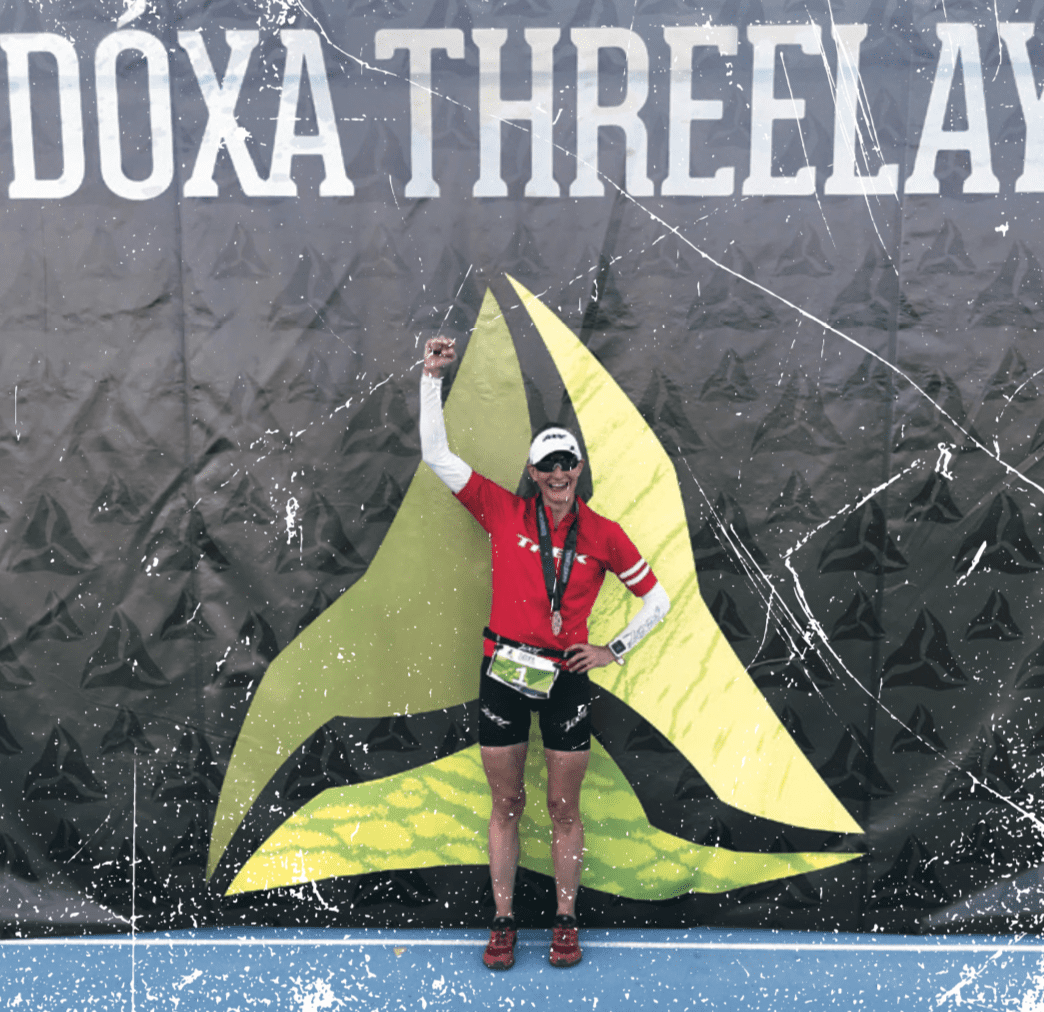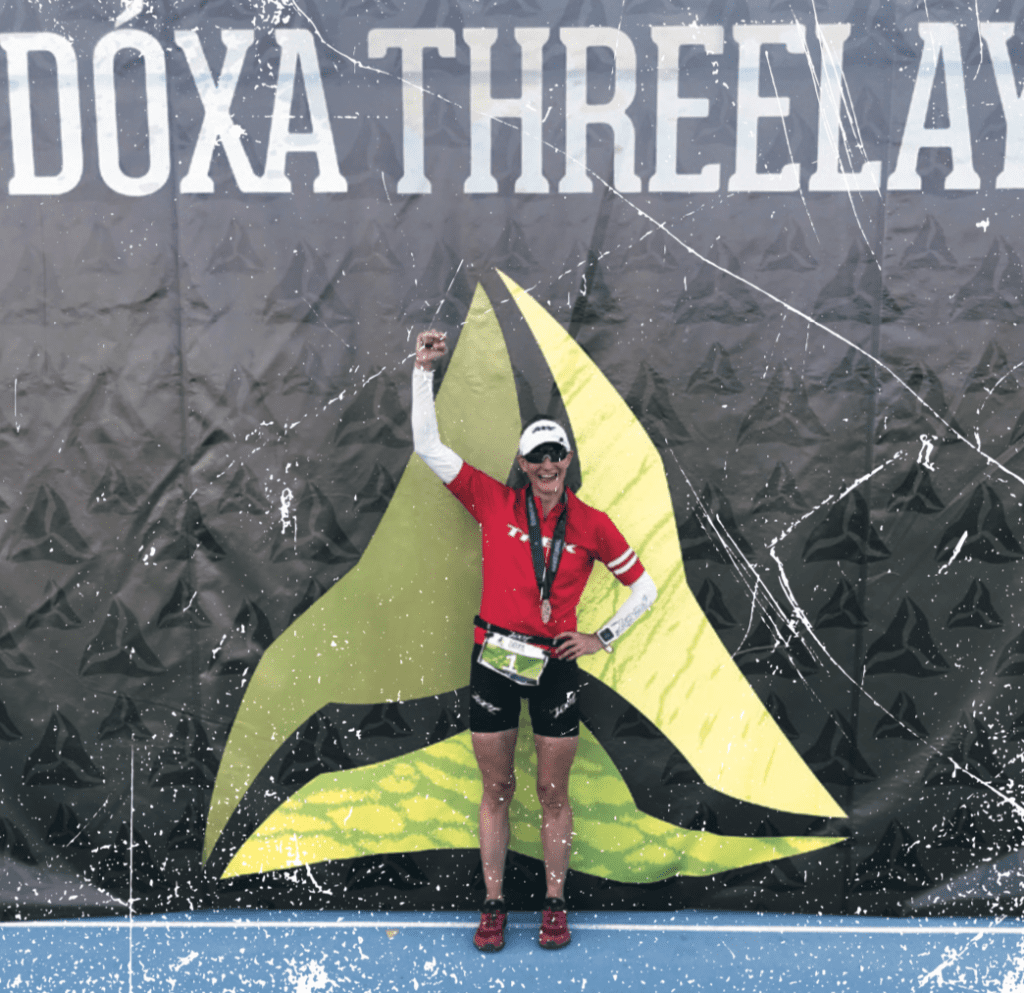Tara Norton: The First Ever Dóxawoman
This year, Torontonian Tara Norton, became the first solo woman to conquer the Dóxa Threelay

— by Helen Powers
The American state of Utah hosts an overnight triathlon that covers 285 miles in a non-stop, two-day timeframe. The Dóxa Threelay is billed as an event to share with teams of 12 people, or, like Torontonian Tara Norton, you can do the whole thing yourself. This year she became the first solo woman to conquer this beast of an event.

The Dóxa race has 36 legs that don’t follow the traditional sequence of swim, bike, run. There are back-to-back legs of each discipline and varying combinations of all three disciplines. This challenges a triathlete in new ways, especially with 28 transitions and a course that includes two mountains with elevations well over 9,000 feet.
In previous years, two men successfully completed the solo course and each were dubbed a Dóxaman. The race directors really wanted to crown a Dóxawoman in 2018 and a friend mentioned Norton to the organizers as a possible contender.
Related: Canadian triathlete becomes Ultraman World Champion
Norton is a former professional triathlete with a passion for ultra-distance races. She competed at the Ironman World Championship in Kona six times with a best 12th place finish. In the Ultraman World Championship in 2016, she was the second woman with a time of 27:56:49.

In November 2017, a Dóxa race director reached out to Norton about their August 2018 race. “He asked if I would attempt their solo category and I said yes,” explains Norton. “I was intrigued by the different sequences of the swim, bike and run legs.”
She had covered similar distances over several days with Ultraman races, but Dóxa would be an all-nighter event and the sleep deprivation would turn out to be a big challenge.
Norton and her dynamic crew downloaded the Official 2018 Dóxa Bible and transformed it into an extraordinary guide. They planned every leg of the race with the details of absolutely everything Norton would need from changes in gear for warm versus cold areas, when her two bikes would be swapped out and when and what she would be eating.
“I knew it was going to come down to mostly nutrition for the race,” says Norton. Things went pretty well until the second afternoon. With several legs left to go, she tried to eat a chewy food supplement and became violently ill. She soldiered on and, later, her stomach recovered well enough for a full meal plus a celebratory beer.
Mental strength was the other huge factor in her success. “It is your mental strength that keeps you going when all you want to do is lie down and quit,” she says. The first of two dark moments came during the night when Norton didn’t want to talk much and she was slurring her words a bit. She had been up at 5 a.m., started the race at 7 a.m. and had been going for 20 hours. So, she lay down for half an hour and got about 20 minutes of much-needed sleep. She would have only one other half-hour rest during the 35-hour race.
Her second dark moment was around 9:30 a.m. on day two when she sat in a transition zone for a long time, wondering about continuing on. Norton still had almost the length of a marathon ahead and, although it was split up into several legs, it was still a daunting prospect at this stage. “My shins and quads were killing me. I had constant muscular pain,” she recalls.
She sat there thinking of Maya, her six-year-old daughter, who was so excited about the first solo Dóxa woman being her Mom. Norton also talked with her sister-in-law, a crew member and a very experienced triathlete.
“I knew I had to start and just keep putting one foot in front of the other,” says Norton. “I really wanted to call it a day but, once that not- so-positive moment passed, I put it behind me and didn’t wonder anymore.”
Norton did not prepare for sleep deprivation before the race, but she did focus on putting good miles in her legs.
“I had three weeks of running 100 km a week, split into smaller segments,” she explains. “I got used to doing multiple runs in a day and also having three or four individual sessions of swimming, biking and running a day, mixing up the usual order.”
Ontario’s humid summer days were great preparation for Utah’s high temperatures, but there wasn’t enough time spent on hill training. Remembering how much her legs hurt, she says, “I would especially recommend downhill running practice for anyone taking on the race because that can be really tough on your legs.”
What she didn’t realize at the time was that a stone was imbedded in her foot for the entire race. It was discovered later by her doctor while looking for a source of lingering pain.
The highlight of the race was crossing the finish line with her whole team, including husband, Bruce, Maya and all the crew.
“We all did a lap together, holding hands,” she says. “We were all so happy. The race experience was pretty fabulous and pretty emotional for everyone as we bonded under the stressful moments.”
As a certified coach, Norton supports others’ triathlon goals, including Chantal Thibault.
“Tara was thrilled to see my progress and is excited about helping others,” says Thibault, “She is a great role model for so many and makes you feel good about your accomplishments even though she’s 100 times better than you.” Thibault was one of many fans who received ongoing updates from Bruce that described Norton’s Dóxa milestones.
Norton really enjoys empowering women and the race was a mission for her and Maya.
“A bonus has been the inspiration it provided to others both during the race and afterward,” she says. “I love pushing my limits and although my time was slower than I would have liked, this was an amazing experience,” declares Norton.
Helen Powers is a regular contributor to Triathlon Magazine Canada. She lives in Dundas, Ont.
